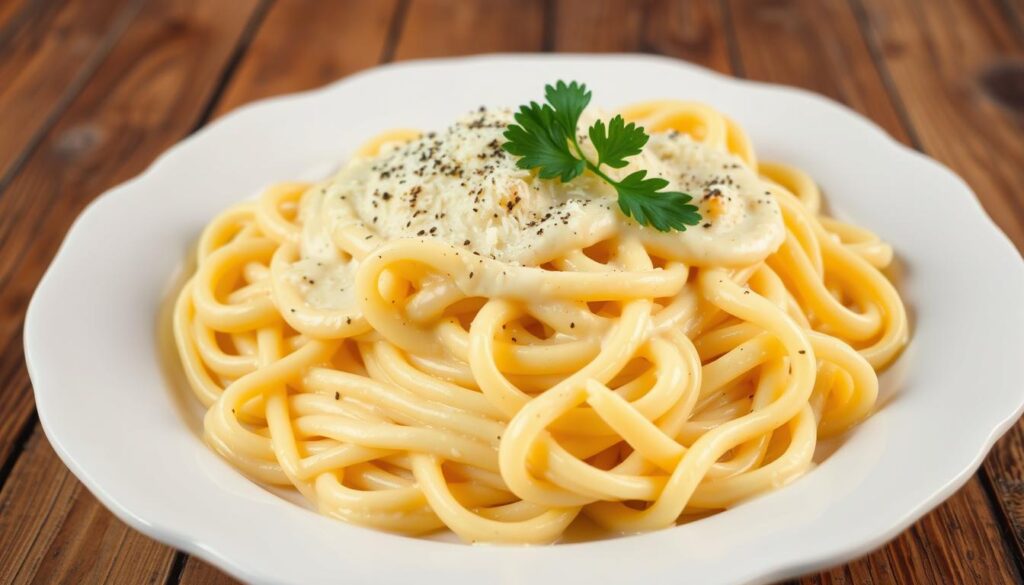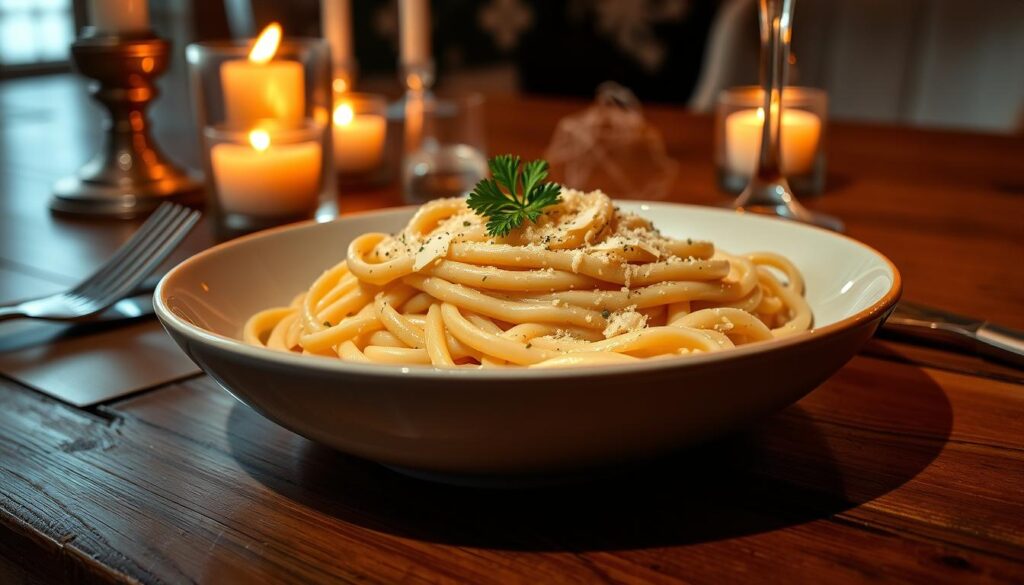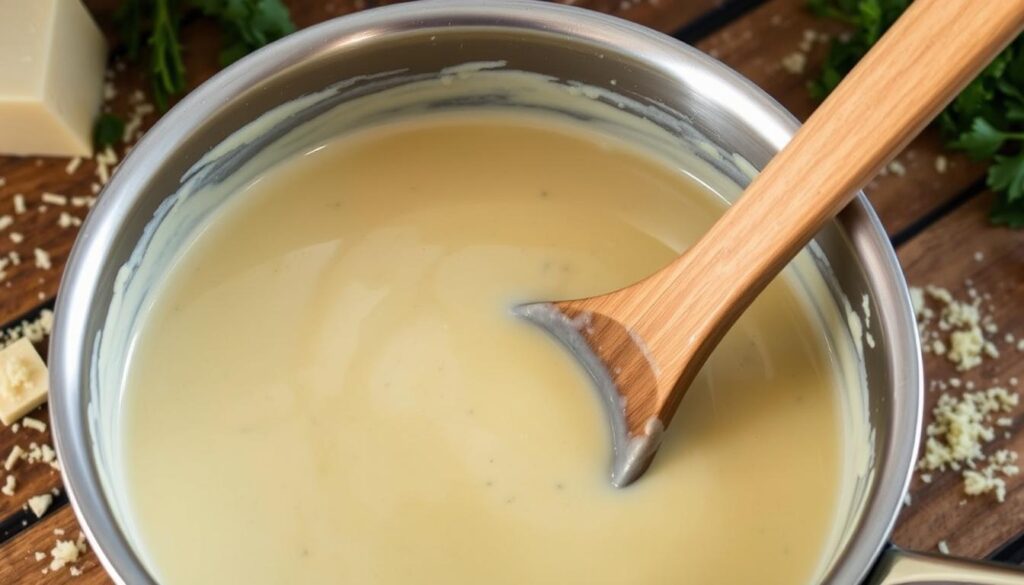


Fettuccine Alfredo is a beloved Italian pasta dish loved worldwide. It's simple yet delicious, making it a top comfort food. The recipe uses just 4 main ingredients: butter, parmesan, salt, and pepper. These ingredients are key to a perfect dish.
The quality of ingredients and technique matter a lot. For the best flavor, use unsalted butter and freshly grated Parmigiano-Reggiano cheese.
This dish can be made in under 20 minutes, perfect for a quick meal. It serves 4 people and cooks fresh pasta in 2–3 minutes. To get the right sauce, save about 1 cup of cooking water. Add it to the sauce a little at a time.
Traditional Alfredo sauce doesn't have cream. It uses only butter and cheese for its creamy texture. This is what makes authentic Fettuccine Alfredo special.
Fettuccine Alfredo has a rich history that started in Rome, Italy, in the early 20th century. It was created by Alfredo di Lelio, who ran a restaurant in Rome. The original recipe was simple, with just fettuccine noodles, parmesan cheese, and butter.
The history of Fettuccine Alfredo is deeply rooted in Rome. Over time, the recipe grew, and new versions appeared, especially in the United States. There, cream was added to the sauce. Yet, the true Fettuccine Alfredo remains a favorite around the world, celebrating its Italian cuisine origins.
Some key facts about Fettuccine Alfredo's history include:
In Rome, Fettuccine Alfredo is still a staple in many restaurants. Its history shows Rome's deep culinary roots. Whether you love food or just enjoy Italian cuisine, Fettuccine Alfredo is sure to impress.
| Year | Event |
|---|---|
| 1914 | Alfredo di Lelio creates Fettuccine Alfredo |
| 1920s | Fettuccine Alfredo becomes popular among American tourists in Italy |
| 1927 | George Rector publishes the recipe in his cookbook |
To make perfect Fettuccine Alfredo, you need the right kitchen equipment. You'll need a large pot for boiling noodles, a colander for draining, and tongs for tossing. A box grater is also needed for grating parmesan cheese.
Having the right cooking utensils makes cooking easier. You'll also need a saucepan for the alfredo sauce, a whisk for mixing, and a wooden spoon for stirring.
A large pot with a heavy bottom is best for boiling noodles. A pasta cooker with a built-in strainer is also handy for draining.
Here are some essential kitchen equipment and cooking utensils you'll need:
https://www.youtube.com/watch?v=dTBG-uhlZgY
With these essential tools, making perfect Fettuccine Alfredo is easy. Choose high-quality kitchen equipment and cooking utensils for better performance and enjoyment.
| Kitchen Equipment | Description |
|---|---|
| Large Pot | For boiling fettuccine noodles |
| Colander | For draining noodles |
| Tongs | For tossing noodles with sauce |
| Box Grater | For grating parmesan cheese |
To make a real Fettuccine Alfredo, you need to focus on the pasta quality. Choose high-quality fettuccine noodles. They should hold the sauce well, making every bite tasty.
For the pasta, use 1 pound. Cook it in 3 inches of water in a 6-quart pot. Only add 1 tablespoon of kosher salt.
Parmesan cheese is another key ingredient. Pick a good parmesan, like 24 months aged or younger. Grate it fresh for the best taste. You'll need 1 cup of grated parmesan for the sauce.
Fresh butter is also crucial. Use high-quality, fresh butter for a creamy sauce. You'll need about 1 stick (113g) of unsalted butter.
| Ingredient | Quantity |
|---|---|
| Fettuccine Pasta | 1 pound |
| Unsalted Butter | 1 stick (approximately 113g) |
| Parmesan Cheese | 1 cup (about 100g) of finely grated |
To make a tasty Fettuccine Alfredo, you need a few key ingredients. You'll need fettuccine noodles, parmesan cheese, butter, and pasta water. This dish cooks in about 15-20 minutes, making it great for a quick dinner.
Here's what you need for the classic Fettuccine Alfredo recipe:
Prep time for this recipe is about 15 minutes, and cooking takes around 12 minutes. It's important to stir the noodles constantly for the first 3-4 minutes to avoid clumps. Each serving is 3/4 cup of cooked noodles.

This recipe makes 4 servings, with each serving having about 373 calories. It's best to serve Fettuccine Alfredo right away, as the sauce can thicken if left out. You can keep leftovers in the fridge for up to 5 days in an airtight container.
| Ingredient | Quantity |
|---|---|
| Fettuccine noodles | 8 ounces |
| Heavy cream | 1 cup |
| Salted butter | 2 tablespoons |
| Parmesan cheese | ½ cup |
To get the perfect Fettuccine Alfredo, pasta cooking is key. The technique is to cook the fettuccine noodles until they're al dente. This means they should still have a bit of chew to them.
Overcooking the noodles makes them mushy. This texture doesn't hold the sauce well. So, it's important to cook them just right.
Cooking fettuccine noodles al dente means cooking them 2-3 minutes less than the package says. Then, finish cooking them in the sauce. This helps them soak up all the flavors.
Here are some tips for cooking fettuccine noodles:
Mastering the pasta cooking technique and getting the perfect al dente texture is crucial. It makes your Fettuccine Alfredo dish delicious and authentic. Use high-quality ingredients like European-style butter and Parmigiano Reggiano cheese to boost the flavor.
Here's a quick summary of what to keep in mind when cooking fettuccine noodles:
| Cooking Time | Water Ratio | Starch Retention |
|---|---|---|
| 3-4 minutes | 1 1/2 quarts per pound | Do not rinse |
To make the perfect Alfredo sauce, controlling temperature and consistency is key. Start by melting butter, then add parmesan cheese and pasta water slowly. Paying close attention to temperature is crucial for the sauce's texture.
The sauce should be creamy and smooth, covering the noodles well. Temperature control is essential here. Too hot, and the cheese melts too fast, making it grainy. Too cold, and it won't melt right, making it too thick.

Common mistakes include adding too much pasta water or not stirring enough. These can make the sauce too thin or separate. To avoid these, keep a close eye on the sauce's consistency and adjust as needed.
The perfect Alfredo sauce is creamy and smooth. Use the right amount of parmesan cheese and pasta water. It should coat the noodles well but still be easy to stir.
The final step in making your Fettuccine Alfredo is assembling the dish. You need to toss the cooked noodles with the Alfredo sauce. Make sure the noodles are well coated. Do this fast, as the sauce thickens quickly.
To add the final touches, sprinkle more parmesan cheese and black pepper if you like. Here are some tips to keep in mind:
By following these steps and tips, you'll make a delicious Fettuccine Alfredo dish. It's sure to impress. Serve it right away and enjoy your hard work!
| Ingredient | Quantity |
|---|---|
| Fettuccine pasta | ¾ lb (around 350 g) |
| Chicken breasts | 4 large, sliced into strips |
| Salted butter | 1 stick (approximately ½ cup) |
To get restaurant-quality Fettuccine Alfredo, focus on timing and how you do things. Pay attention to the butter to cheese ratio. It should be 1 part butter to 1 part cheese for the best creaminess and taste.
Professional chefs have chef secrets that make their dishes special. For Fettuccine Alfredo, it's all about when and how you add ingredients. Make sure noodles are al dente, sauce is the right temperature, and everything is put together fast. This way, your dish will be as good as those in top restaurants.
Some secrets for restaurant-quality results include using the best ingredients. Use freshly grated Parmigiano-Reggiano cheese and pasta water. The pasta water has starch that helps make the sauce smooth.
Timing is key when cooking Fettuccine Alfredo. Browning the butter before mixing with pasta adds flavor. This happens at medium heat in about 3-5 minutes. Assembling the dish quickly, while the noodles are warm, is also important for a creamy sauce.
By following these tips and paying attention to details, you can make a restaurant-quality Fettuccine Alfredo. It will impress your family and friends. The secret is in the timing, how you do things, and using the best ingredients and chef secrets.
When serving Fettuccine Alfredo, presentation is crucial. A beautifully presented dish can make any meal special, ideal for dinner party events. Here are some serving ideas to consider:
Popular sides include steamed veggies, garlic bread, or a simple green salad. For a fancy touch, sprinkle parmesan cheese and add fresh parsley. These add color and freshness to the dish.
Here are some more serving ideas:
A well-presented Fettuccine Alfredo dish impresses at any dinner party. With these serving ideas and presentation tips, you'll create a memorable dining experience for your guests.
| Serving Idea | Description |
|---|---|
| Individual Bowls | Serve the Fettuccine Alfredo in individual bowls for a more intimate setting |
| Large Bowl | Serve the Fettuccine Alfredo in one large bowl for a family-style setting |
Storing and reheating Fettuccine Alfredo right is key. Keep it in an airtight container in the fridge for up to 5 days. This helps keep the dish fresh.
There are a few ways to reheat Fettuccine Alfredo. You can use the microwave, stovetop, or oven. The microwave takes 1-minute intervals, usually 2 to 3 cycles. The stovetop method is best for keeping it creamy.
When reheating, add a bit of water or milk. This keeps the sauce moist. Follow these tips to enjoy your Fettuccine Alfredo for days.
| Reheating Method | Temperature | Time |
|---|---|---|
| Microwave | 70% power | 30-second intervals |
| Stovetop | Medium heat | 5-7 minutes |
| Oven | 325 degrees Fahrenheit | 10-15 minutes |
As we wrap up our journey through the world of Fettuccine Alfredo, it's clear that this dish is more than just a meal. It's a celebration of Italian cuisine, a testament to the art of cooking, and a source of comfort and joy. From its origins in Rome to its global popularity, Fettuccine Alfredo has captured the hearts of many.
Whether you're a seasoned chef or a home cook, mastering the art of Fettuccine Alfredo is a rewarding experience. With the right ingredients, techniques, and presentation, you can create a dish that will impress your guests and leave them craving for more. So, don't be afraid to experiment, try new variations, and make this classic dish your own.
So, the next time you sit down to enjoy a plate of Fettuccine Alfredo, remember the rich history, the cultural significance, and the joy it brings to your table. Savor each bite, appreciate the flavors, and let the creamy sauce and perfectly cooked noodles transport you to the heart of Italy. Bon appétit!
Fettuccine Alfredo started in Rome, Italy, in the early 1900s. Alfredo di Lelio created it. The first recipe had fettuccine, parmesan, and butter.
Later, the recipe changed, especially in the U.S. where cream was added.
You'll need a big pot for boiling noodles, a colander for draining, and tongs for tossing. A box grater is needed for parmesan cheese. These tools make cooking easier.
You need good fettuccine noodles, fresh parmesan cheese, and butter. These ingredients make the dish authentic and tasty.
The classic recipe is simple. It needs fettuccine, parmesan, butter, and pasta water. It takes about 15-20 minutes to make, perfect for a quick dinner.
Cooking fettuccine right is key. They should be al dente, still a bit firm. Overcooking makes them mushy and doesn't hold sauce well.
Making Alfredo sauce is an art. It needs careful attention to temperature and consistency. Melt butter, then add parmesan and pasta water slowly. Keep the sauce creamy and smooth.
Assemble the dish by tossing cooked noodles with the sauce. Serve it hot, topped with more parmesan and black pepper if you like.
For restaurant-quality, focus on timing and detail. Cook noodles al dente, prepare sauce at the right temperature, and assemble quickly. This will make your dish as good as any restaurant's.
Store leftover Fettuccine Alfredo in an airtight container in the fridge for up to 5 days. Reheat it in the microwave or on the stovetop, adding pasta water if needed. Note that reheated sauce might not be as creamy as fresh.